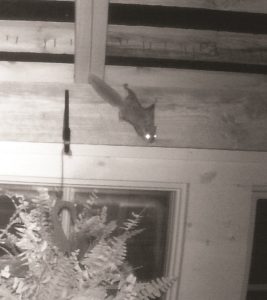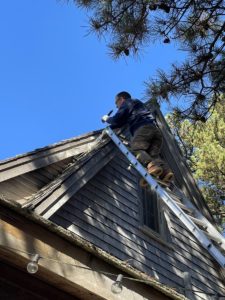WELLFLEET — In the five months since Carl Sussman and Laura Lubetsky first heard the scratching sounds of what turned out to be a populous colony of flying squirrels in the rafters of their living room and sunroom, they’ve trapped 24 specimens.
At first, the squirrels thrilled their cat, Cody, who Sussman describes as “more of a spotter than a catcher.” Upon a first glimpse of a squirrel — light gray and not much larger than a chipmunk — the cat began darting around. “Next thing I knew,” says Lubetsky, “Carl was running around, too.”

Neither Cody nor Carl succeeded in thwarting the squirrel’s mission, which was to find a warm place to nest. Among the odors that attract flying squirrels are the scents produced by others of their kind, according to Chuck Fowler, a licensed problem animal control (PAC) agent of Fowler & Sons Nuisance Wildlife Services in Hyannis. Once comfortably ensconced, they generate plenty of odors. They are also known to chew through materials ranging from wooden beams to drywall.
Sussman and Lubetsky have been in the same Wellfleet house part-time for 13 years and can’t say why it is that the flying squirrels made their entrance only this year. Fowler isn’t sure either.
But flying squirrels have been on his radar for a while. The first time he was hired to handle an infestation was about 15 years ago, he says, at another house in Wellfleet. Based on the droppings — which can awaken the skin-crawling, plague-inspired revulsion evoked by the presence of rodents in the home — Fowler assumed the problem was rats. It turned out to be a case of flying squirrels. And in the decade and a half since, he presumes that the population has been on the rise. Though he hasn’t dealt with other infestations, he says the species is drawn to our woods of oaks and pines and likes to nest in hollow trees. “They live in big colonies out here,” he says.
The Mass. Div. of Fisheries & Wildlife isn’t tuned in to the squirrels’ significant Outer Cape presence. “Northern Flying Squirrel individuals may occur in northern portions of Massachusetts,” the state agency’s site says, “but have not been confirmed in over 40 years.”
To the extent that the vermin elude the eye of the state, they do so not by flying — surprising, perhaps, given their nomenclature — but by gliding. It’s a mode of transport that’s possible thanks to their patagia, folded layers of loose skin between their forelegs and hindlegs.

The animals’ furry, flappy flesh is easy to spot, including through the wildlife camera that Sussman and Lubetsky installed in their sunroom soon after realizing that the squirrels would not leave via gentle escorting. In the 21-megapixel night vision of the Coolife H881 Trail Camera, the squirrels’ black eyes glint as they scamper. Sussman mounted the camera in hopes of discovering the pests’ point of entry, which hasn’t yet become clear.
Once it does, Fowler plans to install one-way doors for the rodent invaders. Usually made of heavy-duty copper, these species-spanning contraptions do not actually trap pests, but instead funnel them to the outdoors. The vermin are first lured into a chamber with morsels of food, then a cage door swings down to block re-entry to the house.
According to the wildlife control company Wildlife Removal, these devices are “the humane way to evict animals.” The company’s site notes there are a few occasions when using one-way funnels might not do the trick, such as when there are many squirrels sharing a nest — something flying squirrels do in winter, though they do not hibernate.
For now, Fowler has employed hardware cloth and expandable foam to plug what he thinks might be a point of entry toward the apex of Sussman and Lubetsky’s cedar A-frame. Because the roof is skip sheathing rather than plywood, there’s plenty of room for the unwanted visitors to find a way in, Fowler says, adding that the shingles appear to overlap enough to preclude the roof’s being an entranceway.
Fowler and his colleagues have visited the home twice since the flying squirrels first showed up and have removed a few of the intruders. According to state law, “Any trapped animal must either be relocated on the premises (within the property) or destroyed humanely.” Sussman traps the squirrels in Havahart traps and releases them outdoors, but that’s clearly not working.
Finding and sealing the place where the squirrels are getting in will be the solution, Fowler says: “We’re going to continue until we find that entry point.”
